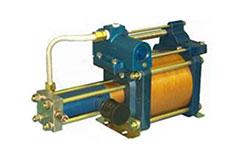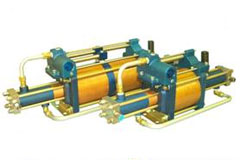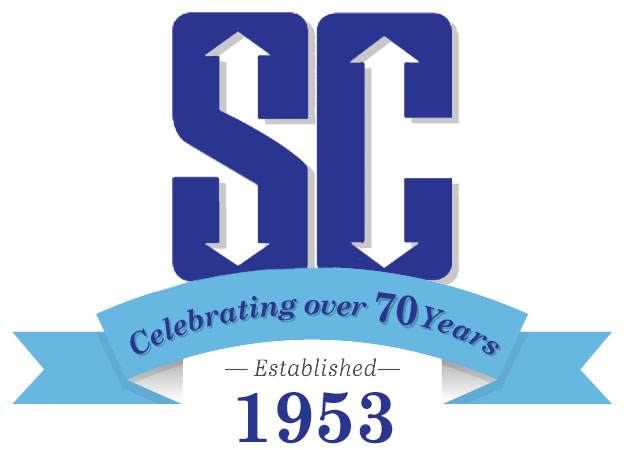

SC air driven gas boosters are self-contained units, using a cycling spool and pilot valve to provide automatic reciprocating action when air or gas is supplied to the air drive inlet.
The drive consists of a large piston and valve assembly directly connected to a hydrocarbon-free pumping piston with self lubricating seals cycling in a stainless barrel that has an integral check valve.
The working surface area of the drive piston exceeds the working surface area of the pump piston, thereby providing the pressure BOOST. This is accomplished by using relatively low pressure air or gas to the drive inlet. The air drive section is pre-lubricated (thus eliminating the need for an air line lubricator), easy to install, and can be mounted in any position eliminating additional floor space. No electrical connections are required.
SC gas boosters are typically used to boost low pressure gas / air to a higher pressure required at the process or test station. Most industrial gases (nitrogen, helium, hydrogen, argon, etc.) are commonly delivered under pressure in steel cylinders. If gas is to be used at low pressures, e.g., welding, the pressurized supply is easily piped and controlled to the point of use with simple valving. However, if the end use requires the gas under pressure, the supply cylinder pressure cannot be utilized after it has fallen to the level of the end use pressure. Therefore, the gas remaining will be wasted unless it is boosted.
If the application requires a pressure greater than the common supply cylinder pressure, a gas booster must be used. Depending on the unit selected, you can boost gas pressure from 25 psi and up to 25,000 psi.
SC gas boosters are suitable for other applications such as bottle filling from nitrogen generators and dewars, hydrogas suspension systems, automotive air gas storage systems, aircraft slide chute gas storage; sulfur hexafluoride (SF6) transfer for arc suppression and insulation of circuit breakers commonly found in the utility industry, breathing air for scuba diving, gas injection molding, etc.
In addition to our complete line of gas boosters, SC also fabricates custom gas booster systems for individual applications. These units are manufactured to customer specifications and can include filters, gauges, pilot switches, panel controls, tubular frames, etc. Contact your distributor or our sales department for more information.
Selecting the right booster for your application
We could fill several pages of formulas, tables, and explanations of how to determine the best, most economical booster for your application.
After plowing through all the information, including types of gas, decaying supply versus constant, displacement factors, volumetric efficiencies and compression ratios, just to name a few, you may still wonder if you are making the right choice.
At SC Hydraulic Engineering we have a better way - CALL US!
Or better yet take a minute to read the glossary of terms below so you know the information we need, then fill out the online Gas Booster Worksheet. Please make sure to fill out the form completely as all the information is important. We'll have an answer for you within a couple of hours with a selection of boosters, fill times if required, pricing, delivery time, and the name of your nearest distributor.
We figure you have better things to do with your time besides doing our job. For the best service in the industry, call SC Hydraulic Engineering.
Glossary of Terms
Pa (Air Drive Pressure)
Pressure from air/gas compressor available at the booster to drive the unit. If the pressure fluctuates, the lowest pressure available is used to calculate the output gas pressure. The Pa, and in some selections, along with the supply pressure will determine the maximum stall pressure of the booster.
Va (Air Drive Flow)
Volume of air/gas measured in SCFM (standard cubic feet per minute) available to drive the unit. The volume of air/gas determines the speed in which the booster will cycle and therefore the volume delivered from the outlet port. The volume of outlet gas also determines the speed in which a vessel is filled to a static pressure.
CPM (Air Drive Speed)
Cycles per minute when operating the booster, which is determined by the volume of drive air/gas available. The CPM is highest when starting to fill a vessel and decreases as the output pressure increases until reaching the static or stall pressure.
Ps (Gas Supply Pressure)
Pressure of the gas from the supply source. If the supply is from a gas generator or very large source, the Ps may be considered constant. If from a smaller source, typically bottles, the Ps will decrease as the supply is used. The decrease in supply will affect the static pressure output (in certain boosters) and the fill time or SCFM of the output.
Vs (Gas Supply Volume)
Volume of the gas available from the supply source. This is measured not by SCFM but by ACF (actual cubic feet) or water volume of the source. If the supply is from a gas generator or very large source, the Vs may be considered unlimited. The ACF of the supply determines how many fills to a certain static pressure can be made until the source is depleted.
Po (Gas Outlet Stall Pressure)
Pressure of the gas at the outlet. This can be stated as an output pressure at a certain SCFM or as the static output stall pressure when filling a vessel.
Vo (Gas Outlet Flow)
The volume of gas delivered at the outlet port measured in SCFM. This can be converted to ACFM if the temperature of the output gas is known using the formula: ACFM = SCFM x 14.696 / (Pa + 14.696) x degrees F. / 530.
Six series available - choose from:




